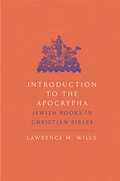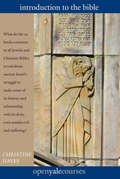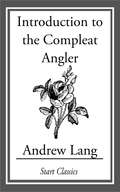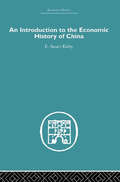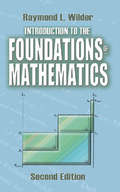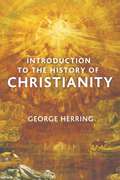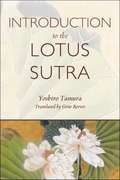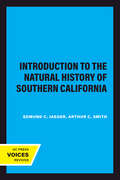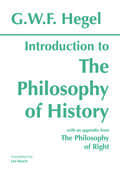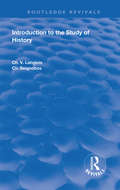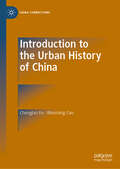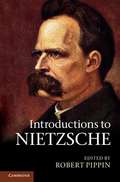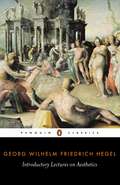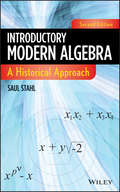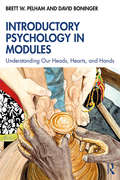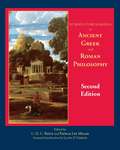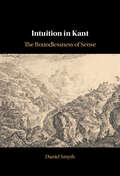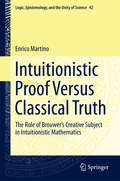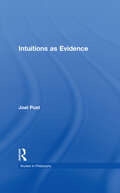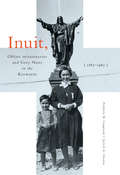- Table View
- List View
Introduction to the Apocrypha: Jewish Books in Christian Bibles
by Lawrence M. WillsAn ambitious introduction to the Apocrypha that encourages readers to reimagine what &“canon&” really means Challenging the way Christian and non-Christian readers think about the Apocrypha, this is an ambitious introduction to the deuterocanonical texts of the Christian Old Testaments. Lawrence Wills introduces these texts in their original Jewish environment while addressing the very different roles they had in various Christian canons. Though often relegated to a lesser role, a sort of &“Bible-Lite,&” these texts deserve renewed attention, and this book shows how they hold more interest for both ancient and contemporary communities than previously thought.
Introduction to the Bible
by Christine HayesThis book examines the small library of 24 books common to all Jewish and Christian Bibles—books that preserve the efforts of diverse writers over a span of many centuries to make sense of their personal experiences and those of their people, the ancient Israelites. Professor Christine Hayes guides her readers through the complexities of this polyphonous literature that has served as a foundational pillar of Western civilization, underscoring the variety and even disparities among the voices that speak in the biblical texts. Biblical authors wrote in many contexts and responded to a sweeping range of crises and questions concerning issues that were political, economic, historical, cultural, philosophical, religious, and moral. In probing chapters devoted to each of the 24 books of the Hebrew Bible, or Old Testament, Hayes reconstructs the meanings and messages of each book and encourages a deeper appreciation of the historical and cultural settings of ancient biblical literature.
Introduction to the Carolingian Age
by Cullen J. ChandlerIntroduction to the Carolingian Age provides an accessible history of western Europe in the eighth and ninth centuries, when arguably a truly European civilization emerged out of the transformed, former world of the Roman Empire.Through a thematical and chronological approach, this book explores the life, family, and period of Charlemagne in a clear and informative way. The secular aristocrats, ecclesiastical figures, and scholars associated with the Carolingian dynasty feature as partners in building the empire and guiding its development, and the social and cultural lives of people from the elite to the common classes are also examined. Through an engaging narrative, this study demonstrates that by the end of the ninth century, the royal house faced a series of challenges that brought about the devolution of the empire into smaller kingdoms and the loosening of the Carolingian family’s grip on monarchy. Based on up-to-date scholarship, Introduction to the Carolingian Age offers explanations of historical developments and discussions of key historiographical debates.This book is an essential resource for both undergraduate students and general readers with an interest in the history of the Carolingian period from 750–900.
Introduction to the Compleat Angler
by Andrew LangTo write on Walton is, indeed, to hold a candle to the sun. The editor has been content to give a summary of the chief or rather the only known, events in Walton's long life, adding a notice of his character as displayed in his Biographies and in The Compleat Angler, with comments on the ancient and modern practice of fishing, illustrated by passages from Walton's foregoers and contemporaries.
Introduction to the Economic History of China
by Stuart KirbyFirst Published in 2005. Routledge is an imprint of Taylor & Francis, an informa company.
Introduction to the Environmental Humanities
by John C. Ryan J. Andrew HubbellIn an era of climate change, deforestation, melting ice caps, poisoned environments, and species loss, many people are turning to the power of the arts and humanities for sustainable solutions to global ecological problems. Introduction to the Environmental Humanities offers a practical and accessible guide to this dynamic and interdisciplinary field. This book provides an overview of the Environmental Humanities’ evolution from the activist movements of the early and mid-twentieth century to more recent debates over climate change, sustainability, energy policy, and habitat degradation in the Anthropocene era. The text introduces readers to seminal writings, artworks, campaigns, and movements while demystifying important terms such as the Anthropocene, environmental justice, nature, ecosystem, ecology, posthuman, and non-human. Emerging theoretical areas such as critical animal and plant studies, gender and queer studies, Indigenous studies, and energy studies are also presented. Organized by discipline, the book explores the role that the arts and humanities play in the future of the planet. Including case studies, discussion questions, annotated bibliographies, and links to online resources, this book offers a comprehensive and engaging overview of the Environmental Humanities for introductory readers. For more advanced readers, it serves as a foundation for future study, projects, or professional development.
Introduction to the Foundations of Mathematics: Second Edition (Dover Books on Mathematics)
by Raymond L. WilderThis classic undergraduate text acquaints students with the fundamental concepts and methods of mathematics. In addition to introducing many historical figures from the 18th through the mid-20th centuries, it examines the axiomatic method, set theory, infinite sets, groups, intuitionism, formal systems, mathematical logic, and other topics. 1965 second edition.
Introduction to the History of Christianity
by George HerringChristianity is the world’s largest religion, and has had a profound impact on the course of civilization. Introduction to the History of Christianity is a beautifully crafted and clearly written introduction to Christianity over its 2000 year history. The broad underlying theme of the book is the interaction between Christianity and the secular world, exploring how one has shaped and been shaped by the other. The volume does not attempt to cover the whole of Christian history in detail. It focuses on three key chronological periods pivotal in the development of Christianity: Christ and Caesar, Christianity circa 300–500; Expansion and Order, Latin Christendom, circa 1050–1250; and Grace and Authority, Western Christianity, circa 1450–1650, as well as a concluding section on Christianity in the modern world, providing illustrative snapshots of the tradition over the course of its long development. In addition, the volume includes maps, timelines, quotations from primary source material, a glossary, and a further reading section. No staid, laborious introduction to its subject, Introduction to the History of Christianity offers an inviting and informative overview of this rich religious tradition.
Introduction to the History of Christianity
by Tim DowleyNow in its third edition, Tim Dowley's masterful one-volume survey of church history has an updated design and new content, particularly in the section covering most recent Christian history. The inviting full-color format includes many new images and updated maps, while maintaining many of the features that made the second edition a popular volume for the classroom. Dowley has assembled a global cast of respected scholars to write the full story of the rise of the Christian faith and to provide a rounded picture of the worldwide development of Christianity. The volume has been praised as accurate, scholarly, and balanced. Its writers are committed to Christianity but also to the unhindered pursuit of truth that does not avoid the darker aspects of the varied story of Christianity. <P><P>The accessible text is supported by detailed timelines, maps, profiles of key figures in Christianity, colorful images, and a complete glossary. Each section includes questions for discussion.
Introduction to the Lotus Sutra
by Gene Reeves Michio Shinozaki Yoshiro TamuraThe Lotus Sutra--one of the most popular Buddhist classics--is here accessibly introduced by one of its most eminent scholars."Soon after entering university in December of 1943, I was sent to the front as a student soldier. I wondered if I were allowed to bring but a single book on the trip, possibly to my death, which would I want to bring. It was the Lotus Sutra" -- from the author's Preface. Having developed a lifelong appreciation of the Lotus Sutra -- even carrying a dog-eared copy with him through service in World War II -- Yoshiro Tamura sought to author an introduction to this beloved work of Buddhist literature. Tamura wanted it to be different than other basic explorations of the text; his introduction would be plain-spoken, relevant and sensitive to modern concerns, and well-informed by contemporary scholarship. He succeeded marvelously with Introduction to the Lotus Sutra, which Gene Reeves -- Tamura's student and translator of the popular English edition of The Lotus Sutra -- translates and introduces in English for the first time here. Tackling issues of authenticity in the so-called "words of Buddha," the influence of culture and history on the development of the Lotus Sutra, and the sutra's role in Japanese life, Introduction to the Lotus Sutra grounds this ancient work of literature in the real, workaday world, revealing its continued appeal across the ages.
Introduction to the Natural History of Southern California (California Natural History Guides #13)
by Edmund C. Jaeger Arthur C. SmithThis title is part of UC Press's Voices Revived program, which commemorates University of California Press’s mission to seek out and cultivate the brightest minds and give them voice, reach, and impact. Drawing on a backlist dating to 1893, Voices Revived makes high-quality, peer-reviewed scholarship accessible once again using print-on-demand technology. This title was originally published in 1966.This title is part of UC Press's Voices Revived program, which commemorates University of California Press’s mission to seek out and cultivate the brightest minds and give them voice, reach, and impact. Drawing on a backlist dating to 1893, Voices Revived</DIV
Introduction to the Philosophy of History: with selections from The Philosophy of Right
by Georg Wilhelm Friedrich Hegel Leo Rauch. . . eminently readable . . . admirably picks up the spirit of what Hegel is saying. . . . more readable and accurate than Hartmann's, and it translates a more readable text than does Nisbet's. It includes (as Hartmann's does not) an excerpt, which serves as chapter five, from 'The Geographical Basis of History' (particularly interesting for what it says of America), and a brief chapter six, entitled 'The Division of History.' The volume closes with an appendix, translating §§341-360 of Hegel's Philosophy of Right and deals directly with the very concept of 'World History.' It constitutes a big help in coming to grips with what Hegel means by 'Spirit.' --Quentin Lauer, SJ, Fordham University, in International Philosophical Quarterly
Introduction to the Study of History (Routledge Revivals)
by CH. V. Langlois CH. SeignobosOriginally translated and published in 1906, this volume is a full translation of Langlois and Seignobos' Introduction to the Study of History and contains chapters on the search for documents, textual criticism, critical investigation of authorship, and interpretative criticism.
Introduction to the Urban History of China (China Connections)
by Chonglan Fu Wenming CaoThis book explores China’s urban development, examining the history and culture of Chinese cities and providing a cultural background to the rapid urban development of contemporary China. It offers a new perspective on Chinese urban history, showcasing the traditional culture which underpins the emergence of the modern city and highlighting how traditional Chinese philosophical thought is reflected in the culture of urban planning and architecture in China, notably examining such issues as ‘the integration of man and nature’, yin and yang, bagua, and the Wu Xing.
Introductions to Nietzsche
by Robert B. PippinFriedrich Nietzsche (1844–1900) is one of the most important philosophers of the last two hundred years, whose writings, both published and unpublished, have had a formative influence on virtually all aspects of modern culture. This volume offers introductory essays on all of Nietzsche's completed works and also his unpublished notebooks. The essays address such topics as his criticism of morality and Christianity, his doctrines of the will to power and the eternal recurrence, his perspectivism, his theories of tragedy and nihilism and his thoughts on ancient and modern culture. Written by internationally recognized scholars, they provide the interested reader with an up-to-date and authoritative overview of the thought of this fascinating figure.
Introductory Lectures on Aesthetics
by Georg HegelNo philosopher has held a higher opinion of art than Hegel, yet nor was any so profoundly pessimistic about its prospects - despite living in the German golden age of Goethe, Mozart and Schiller. For if the artists of classical Greece could find the perfect fusion of content and form, modernity faced complicating - and ultimately disabling - questions. Christianity, with its code of unworldliness, had compromised the immediacy of man's relationship with reality, and ironic detachment had alienated him from his deepest feelings. Hegel's Introductory Lectures on Aesthetics were delivered in Berlin in the 1820s and stand today as a passionately argued work that challenged the ability of art to respond to the modern world.
Introductory Modern Algebra
by Saul StahlPraise for the First Edition"Stahl offers the solvability of equations from the historical point of view...one of the best books available to support a one-semester introduction to abstract algebra."--CHOICEIntroductory Modern Algebra: A Historical Approach, Second Edition presents the evolution of algebra and provides readers with the opportunity to view modern algebra as a consistent movement from concrete problems to abstract principles. With a few pertinent excerpts from the writings of some of the greatest mathematicians, the Second Edition uniquely facilitates the understanding of pivotal algebraic ideas.The author provides a clear, precise, and accessible introduction to modern algebra and also helps to develop a more immediate and well-grounded understanding of how equations lead to permutation groups and what those groups can inform us about such diverse items as multivariate functions and the 15-puzzle. Featuring new sections on topics such as group homomorphisms, the RSA algorithm, complex conjugation, the factorization of real polynomials, and the fundamental theorem of algebra, the Second Edition also includes:An in-depth explanation of the principles and practices of modern algebra in terms of the historical development from the Renaissance solution of the cubic equation to Dedekind's idealsHistorical discussions integrated with the development of modern and abstract algebra in addition to many new explicit statements of theorems, definitions, and terminologyA new appendix on logic and proofs, sets, functions, and equivalence relationsOver 1,000 new examples and multi-level exercises at the end of each section and chapter as well as updated chapter summariesIntroductory Modern Algebra: A Historical Approach, Second Edition is an excellent textbook for upper-undergraduate courses in modern and abstract algebra.
Introductory Psychology in Modules: Understanding Our Heads, Hearts, and Hands
by Brett Pelham David BoningerIntroductory Psychology in Modules: Understanding Our Heads, Hearts, and Hands is a unique and comprehensive introduction to psychology. It consists of 36 short modules that keep students engaged with humor, a narrative style, and hands-on activities that facilitate interactive learning and critical thinking. Each stand-alone module focuses on a major topic in psychology, from the brain, sensation, memory, and cognition to human development, personality, social psychology, and clinical psychology. The modular format also allows a deep dive into important topics that have less coverage in other introductory psychology textbooks. This includes cross-cultural psychology, stereotypes and discrimination, evolutionary psychology, sex and gender, climate change, health psychology, and sport psychology. This truly modular format – ideal for both face to face and virtual learning – makes it easy for instructors to customize their readings and assign exactly what they wish to emphasize. The book also contains an abundance of pedagogical features, including numerous hands-on activities and/or group discussion activities, multiple-choice practice quizzes, and an instructor exam bank written by the authors. By covering both classic and contemporary topics, this book will delight students and instructors alike. The modular format also makes this a useful supplementary text for classes in nursing, medicine, social work, policing, and sociology.
Introductory Readings in Ancient Greek and Roman Philosophy
by Lloyd P. Gerson C. D. Reeve Patrick Lee MillerA concise anthology for the ancient philosophy survey that ranges from the Presocratics through the Neoplatonists, Introductory Readings in Ancient Greek and Roman Philosophy features essential selections from C.D.C. Reeve's 2004 translation of Plato's Republic, which casts reported speech into direct dialogue, as well other translations known for their accuracy and accessibility. Introductions and notes are also included.
Intuition in Kant: The Boundlessness of Sense
by Daniel SmythIn this book Daniel Smyth offers a comprehensive overview of Immanuel Kant's conception of intuition in all its species – divine, receptive, sensible, and human. Kant considers sense perception a paradigm of intuition, yet claims that we can represent infinities in intuition, despite the finitude of sense perception. Smyth examines this heterodox combination of commitments and argues that the various features Kant ascribes to intuition are meant to remedy specific cognitive shortcomings that arise from the discursivity of our intellect Intuition acting as the intellect's cognitive partner to make knowledge possible. He reconstructs Kant's conception of intuition and its role in his philosophy of mind, epistemology, and philosophy of mathematics, and shows that Kant's conception of sensibility is as innovative and revolutionary as his much-debated theory of the understanding.
Intuitionistic Proof Versus Classical Truth: The Role Of Brouwer's Creative Subject In Intuitionistic Mathematics (Logic, Epistemology, and the Unity of Science #42)
by Enrico MartinoThis book examines the role of acts of choice in classical and intuitionistic mathematics. Featuring fifteen papers – both new and previously published – it offers a fresh analysis of concepts developed by the mathematician and philosopher L.E.J. Brouwer, the founder of intuitionism.The author explores Brouwer’s idealization of the creative subject as the basis for intuitionistic truth, and in the process he also discusses an important, related question: to what extent does the intuitionistic perspective succeed in avoiding the classical realistic notion of truth? The papers detail realistic aspects in the idealization of the creative subject and investigate the hidden role of choice even in classical logic and mathematics, covering such topics as bar theorem, type theory, inductive evidence, Beth models, fallible models, and more. In addition, the author offers a critical analysis of the response of key mathematicians and philosophers to Brouwer’s work. These figures include Michael Dummett, Saul Kripke, Per Martin-Löf, and Arend Heyting.This book appeals to researchers and graduate students with an interest in philosophy of mathematics, linguistics, and mathematics.
Intuitions as Evidence
by Joel PustFirst published in 2000. Routledge is an imprint of Taylor & Francis, an informa company.
Intuitions as Evidence (Studies In Philosophy Ser.)
by Joel PustFirst published in 2000. Starting with Kripke's quotation on intuitive content being philosophic evidence, in this essay, the author aims to demonstrate how contemporary philosophy relies on intuitions as evidence, to explain what intuitions are and show why certain contemporary arguments against the use of intuitions as evidence fail.
Inuit, Oblate Missionaries, and Grey Nuns in the Keewatin, 1865-1965
by Jarich G. Oosten Frédéric B. LaugrandOver the century between the first Oblate mission to the Canadian central Arctic in 1867 and the radical shifts brought about by Vatican II, the region was the site of complex interactions between Inuit, Oblate missionaries, and Grey Nuns – interactions that have not yet received the attention they deserve. Enriching archival sources with oral testimony, Frédéric Laugrand and Jarich Oosten provide an in-depth analysis of conversion, medical care, education, and vocation in the Keewatin region of the Northwest Territories. They show that while Christianity was adopted by the Inuit and major transformations occurred, the Oblates and the Grey Nuns did not eradicate the old traditions or assimilate the Inuit, who were caught up in a process they could not yet fully understand. The study begins with the first contact Inuit had with Christianity in the Keewatin region and ends in the mid-1960s, when an Inuk woman joined the Grey Nuns and two Inuit brothers became Oblate missionaries. Bringing together many different voices, perspectives, and experiences, and emphasizing the value of multivocality in understanding this complex period of Inuit history, Inuit, Oblate Missionaries, and Grey Nuns in the Keewatin, 1865–1965 highlights the subtle nuances of a long and complex interaction, showing how salvation and suffering were intertwined.
Inuit, Oblate Missionaries, and Grey Nuns in the Keewatin, 1865-1965
by Jarich G. Oosten Frédéric B. LaugrandOver the century between the first Oblate mission to the Canadian central Arctic in 1867 and the radical shifts brought about by Vatican II, the region was the site of complex interactions between Inuit, Oblate missionaries, and Grey Nuns – interactions that have not yet received the attention they deserve. Enriching archival sources with oral testimony, Frédéric Laugrand and Jarich Oosten provide an in-depth analysis of conversion, medical care, education, and vocation in the Keewatin region of the Northwest Territories. They show that while Christianity was adopted by the Inuit and major transformations occurred, the Oblates and the Grey Nuns did not eradicate the old traditions or assimilate the Inuit, who were caught up in a process they could not yet fully understand. The study begins with the first contact Inuit had with Christianity in the Keewatin region and ends in the mid-1960s, when an Inuk woman joined the Grey Nuns and two Inuit brothers became Oblate missionaries. Bringing together many different voices, perspectives, and experiences, and emphasizing the value of multivocality in understanding this complex period of Inuit history, Inuit, Oblate Missionaries, and Grey Nuns in the Keewatin, 1865–1965 highlights the subtle nuances of a long and complex interaction, showing how salvation and suffering were intertwined.
